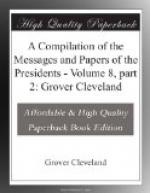Connected with this subject, although, like it, wholly irrelevant, is another conclusion which Messrs. Mudge and Featherstonhaugh attempt to draw from the same grant to Sir William Alexander. That charter directs the line “versus septentrionem” to be produced “ad proximam navium stationem, fluvium, vel scaturiginem in magno fluvio de Canada sese exonerantem.” It can hardly be credited that, although a literal translation of this passage is given, including the whole of the three terms naval station, river, or spring, that it is attempted to limit the meaning to the first expression only, and to infer that as Quebec, in their opinion, is the first naval station above Gaspe on the St. Lawrence, the line “versus septentrionem” was intended to be drawn toward that place, but that as “spring” is also mentioned the line must stop at the source of the Chaudiere. Now it has been uniformly maintained by British authorities, and most strongly in the discussion which preceded the War of 1756, that Nova Scotia extended to the St. Lawrence. The boundary of Sir William Alexander’s grant was therefore to be changed from a geographical line to a water course as soon as it met with one, and the apparently useless verbiage was introduced to meet every possible contingency. Supposing, however, that it did not extend so far, the northwest angle of his Nova Scotia will be where the meridian line of the St. Croix crosses the Beaver Stream running into Lake Johnson, only a mile to the north of the point maintained by the American claim to be such.
The map of L’Escarbot, quoted by Messrs. Mudge and Featherstonhaugh, illustrates both this point and the second instance in which the term “versus septentrionem” is employed. On that map, due north of the Bay of St. Marys, a deep inlet of the Bay of Fundy is represented, and, continuing in the same direction, a deep inlet of the St. Lawrence is figured. The latter does not exist, but this map shows that it was believed to exist at the time of the grant, and must be the “statio navium” of that instrument.
This inlet of the Bay of Fundy occupies the position of the St. John, which is almost due north by the most recent determination from St. Marys Bay, and is so represented on their own map. That the St. John was by mistake arising from this cause taken for the St. Croix in the charter to Alexander is obvious from its being described as lying between the territories of the Etchemin and Souriquois. Now Etchemin, or canoe men, is the name given by the Micmac Indians to the race of the Abenakis, from their skill in the management of the canoe; and this race has always inhabited the river, whence one of their tribes is still called St. John’s Indians. The language of this tribe, although they have lived apart for many years, is still perfectly intelligible by the Indians of the Penobscot, and those in the service of the commission conversed with perfect ease with the Indians of Tobique. Massachusetts, then,




